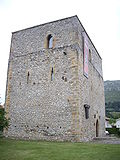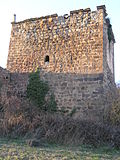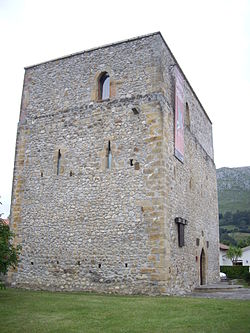| Image | Name | Century | Municipality | Figure of protection | Notes |
|---|
| Tower of Cabanzón | 12th century | Herrerías | Well of cultural interest (1992) | Has barbican quite well preserved, high and with loopholes. It is demolished the top. |
 | Tower-house of the Calderón de La Barca | 12th century | Santillana del Mar | Well of local interest (2002) | Ancient medieval tower transformed into a tower house. Owned pit and Barbican. |
| Castle of Agüero | 13th century | Marina de Cudeyo | Law 16/1985 | Wide and lowest form, which earned it the name of the castle, although are not fit to the Castilians. |
 | Tower of Mogrovejo | 13th century | Camaleño | Well of cultural interest (1985) | Medieval tower then transformed tower-house, with perimeter wall. |
| Castle of Montehano | 13th century | Escalante | Well of cultural interest (1993) | Had barbican and blind towers at the corners. |
 | Tower of Estrada | 13th century | Val de San Vicente | | It has wall and chapel. |
 | Tower of Carrejo | 13th century | Cabezón de la Sal | Well of cultural interest (1984) | Transformed into palace [10] in the 18th century. Today is the Museum of Nature of Cantabria. |
| Tower of Proaño | 13th century | Brotherhood of Campoo de Suso | Well of cultural interest (¿?) | |
| Tower La Guerra | 13th century | Mazcuerras | | Converted into tower-house in the 15th century and later extensively renovated. |
| Tower of las Henestrosas | 13th century | Valdeolea | Law 16/1985 | Tower converted then into castle. |
| Tower of Hojamarta | 13th century | Reocín | Well of cultural interest (1982) | Beside was built the palace of the Bustamante of Quijas. |
| Tower of Quijas | 13th century | Reocín | | |
 | Tower of Velo | | Piélagos | | Big tower located in the town of Puente Arce. |
 | Tower of Venero | | Arnuero | Law 16/1985 | Rebuilt one of its walls that was collapsed. |
| Tower of Cabrahigo | 14th century | Arnuero | Well of cultural interest (1992) | |
| Castle of Allendelagua | 14th century | Castro Urdiales | Law 16/1985 | Only remain the startups of the walls. |
| Tower of Gajano | 14th century | Marina de Cudeyo | | Renovated in the 16th century. Has a skylight of 19th. [11] |
 | Tower del Condestable | | Colindres | Law 16/1985 | A palace was built around the tower thus became an integral part thereof. |
 | Tower del Infantado | 14th century | Potes | Well of cultural interest (1983) | |
 | Tower of Pero Niño | 14th century | San Felices de Buelna | Well of cultural interest (1983) | |
 | Tower del Merino | 14th century | Santillana del Mar | | |
 | Tower of Ruerrero | 14th century | Valderredible | Well of cultural interest (1992) | Are preserved remains of a moat. It has a cylindrical body as an abutment. |
| Tower of San Martín de Hoyos | 14th century | Valdeolea | Well of cultural interest (¿2004?) | |
| Tower del Pontón | 14th century | Peñarrubia | | The exterior retains full. [12] |
| Tower of la Vega | 14th century | Comillas | Ley 16/1985 | Restored. |
 | Tower of don Beltrán de la Cueva | 15th century
(or 16th century) | Santillana del Mar | Well of cultural interest (1981) | Leads attached a palace. |
| Tower of los Velasco | 15th century | Soba | Well of cultural interest (1992) | |
| Tower of San Martín de la Arena | 15th century | Suances | | |
 | Tower of Don Borja | 15th century | Santillana del Mar | | It was probably built on an earlier medieval tower. |
| Towers of Bores | 15th century | Vega de Liébana | | Two similar towers along the way to the neighborhood of Campo (Bores). One of them is fairly well preserved, while the other missing parts and threatens ruin. |
| Tower of los Bustamante | 15th century | Campoo de Yuso | Well of cultural interest (1985) | Two nearby similar towers were demolished in the 18th century by threatening ruin. |
| Tower of Terán | 15th century | Cabuérniga | | Restored. |
 | Torreón of Cartes | 15th century | Cartes | Well of cultural interest (1985) | |
| Tower of Orejón de la Lama | 15th century | Potes | | Located in the neighborhood of Sol. Three levels and relatively good conservation. |
| Tower of Villegas | 15th century | Santiurde de Toranzo | Well of cultural interest (1992) | Renaissance fortified house. [13] |
 | Tower-house of los Alvarado | 16th century | Medio Cudeyo | | |
 | Tower of Cadalso | 16th century | Valderredible | Well of cultural interest (1992) | |
| Tower of los Barreda | 16th century | Suances | | Located in Cortiguera, formerly it belonged to a missing fortress. |
| Tower of los Ezquerra | 16th century | Soba | | |
| Tower of Gómez de Bárcena | 16th century | San Miguel de Aguayo | | Good condition. |
| Tower of Hoz | 16th century | Laredo | Law 16/1985 | |
| Tower-house of los Zorrilla | 16th century | Soba | | |
 | Tower of Pronillo | | Santander | Law 16/1985 | Transformed into a palace in the middle of 16th century. |
| Tower-house of Riva Herrera | 16th century | Marina de Cudeyo | Well of cultural interest (1992) | |
| Tower-house of Ruiz Bustamante | 17th century | Corvera de Toranzo | Historic and artistic complex (1985) | |
| Tower of Agüero | 17th century | Corvera de Toranzo | Law 16/1985 | Two-storey building added later. Good condition. |
| Tower-house of Bustamente Rueda | 17th century | Corvera de Toranzo | | Historic and artistic complex (1985) |
| Tower of Caviedes | 18th century | Valdáliga | | Existed in Caviedes another tower of the 13th century, now defunct. |
| Tower of Acereda | Unknown | Santiurde de Toranzo | | Totally ruined. It was destroyed in the 15th century by the Marquis of Aguilar de Campoo and Count of Castañeda Garci Fernández Manrique. [13] |
| Tower of Barriomonte | | Guriezo | Law 16/1985 | |
| Tower of Berdeja | | Peñarrubia | | Only remain the foundations. [12] |
| Tower of Carasa | | Voto | Law 16/1985 | |
| Tower of Ceballos | | Corvera de Toranzo | | |
| Castle of Cobejo | | Molledo | | |
| Tower of Cos | | Mazcuerras | | |
| Tower of Donadío | | Selaya | | Medieval tower embedded in a construction of 18th century for conversion into palace. |
| Tower of Espina | | Ampuero | Law 16/1985 | |
| Tower of Hoznayo | | Entrambasaguas | Law 16/1985 | |
| Tower of Jado | | Argoños | | Law 16/1985 |
| Tower of Mazcuerras | | Mazcuerras | Law 16/1985 | |
| Tower of Otañes | | Castro Urdiales | Ley 16/1985 | Have annexed old buildings in two of its sides, making tower-house. |
| Tower of Penagos | | Penagos | Law 16/1985 | |
| Tower of Piedrahita | | Peñarrubia | | Only preserves some canvases of walls. [12] |
| Tower del Rebollar | | Arnuero | | Law 16/1985 |
| Tower of Roiz | | Valdáliga | | |
| Tower of Rubín de Celis | | Rionansa | | |
| Tower of Ruente | | Ruente | | Converted into hotel. [14] |
| Tower of San Miguel de Aguayo | | San Miguel de Aguayo | Law 16/1985 | |
 | Torre de San Telmo | | Suances | Law 16/1985 | Only preserved part of two of its walls. |
| Tower of Secadura | | Voto | Law 16/1985 | |
| Tower of los Señores de Isla | | Arnuero | | |
| Tower of Treto | | Bárcena de Cicero | Law 16/1985 | |
| Tower of Velo | | Piélagos | Well of cultural interest (1983) | Medieval tower extended and fenced to make it palace compound during the 16th and 17th centuries, located in Renedo. |
| Tower of la Villa | | Marina de Cudeyo | Law 16/1985 | |
 | Tower of Villacarriedo | | Villacarriedo | Well of cultural interest | Now part of the Palace of Soñanes, which is building in around him, preserving it. |
| Tower of Villapresente | | Reocín | | |
| Castle of Villegas | | Alfoz de Lloredo | | |
 | Castle of Vispieres | | Santillana del Mar | Law 16/1985 | Remains of a fortified tower built on Roman and Castro ruins. |
| Tower of Zurita | | Piélagos | Law 16/1985 | |























